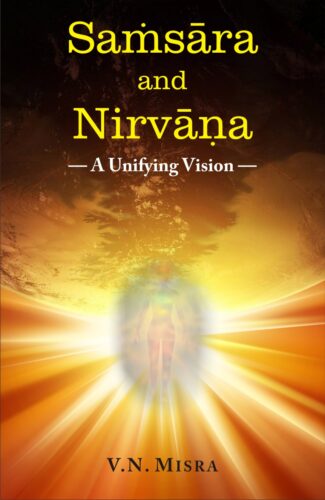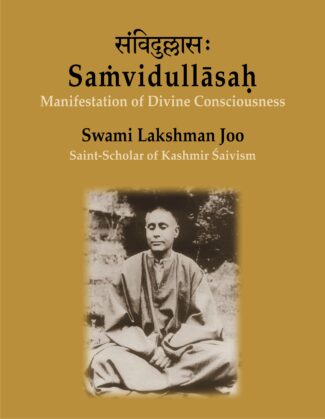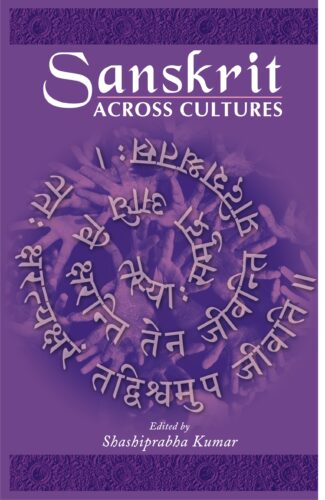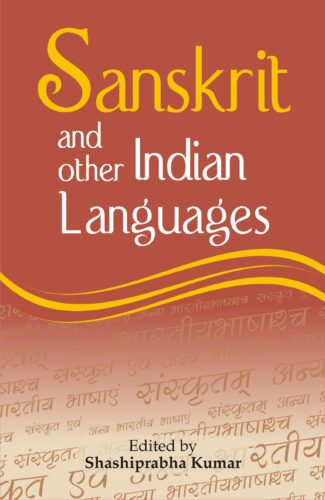Showing 831–840 of 1165 results

This book tries to look at samnyasins and the samnyasashrama in their long existence from the times of Shankara to the present day and also throws light on how scholars, common people, as well as the samnyasins themselves view their roles, both as individual personalities and as persons living in an institution relating to society as a whole.
The present book, Samnyasins in the Hindu Tradition: Changing Perspectives, covers a wide territory, trying to look at the samnyasins and the samnyasashrama in their long existence from the times of Shankara to the present day. This book traverses a slightly different trajectory from the usual book on samnyasins as it attempts an overview of the samnyasin and the institution over a long period from Vedic to post-Independence times and speculates on the future of the institution as well. Samnyasins and scholars not only from India, but from countries as diverse as Canada, South Africa, UK and USA also figure in this collection. The samnyasashramas covered also range from the traditional Advaita, Vishishthadvaita and Dvaita to include many more later ashrams such as the Vira Shaiva (Lingayat), Dharmapuram Adheenam, Arya Samaj, Shivananda Ashram, Ramakrishna Mission, Swami Narayan and many others. Another departure from other books on the subject is that it also compares institutions like the Ramakrishna Mission for instance, as they function in India and in foreign countries where they have established ashrams. In the midst of varied opinions regarding the samnyasin and the samnyasashrama this book will throw light on how scholars, common people, as well as the samnyasins themselves view their roles, both as individual personalities and as persons living in an institution relating to society as a whole.

A unifying vision between Samsara and Nirvana has been presented in this study by placing human beings at the centre of the universe. It draws the inferences under discussion from the different systems of Indian philosophy and the philosophy of the West.
A unifying vision between Samsara and Nirvana has been presented in this study by placing human beings at the centre of the universe. Once this is accepted, the role of God turns to be nothing. This fact is not acceptable to most of the schools of Indian philosophy because of their strong faith in Brahman (God) as the creator of the universe. In that, this study raises the fundamental question. Why Brahman, being the creator, sustainer and dissolver of the universe, has taken such a long time of more than three billion years after the solar system to provide the conditions for the evolution of human life? Since the first cause of universe is the most difficult question, it is suggested to see the creator on the creation itself.
An inference has been drawn that the action (karma) of human beings cannot be treated as ignorance, once it is accepted that human beings are at the centre of the universe. We human beings have nothing else except the freedom of action (karma). In fact, karma itself is freedom.
This volume, in a way, an offshoot of the authors earlier work, Science of Consciousness draws the inferences based on the different systems of Indian philosophy and the philosophy of the West.

This volume is a Birth Centenary tribute to Swami Lakshman Joo Raina (1907-1991), a great saint and scholar of Kashmir, who revived the tradition of Kashmir Shaivism. The articles by scholars, disciples and devotees reflect on his life and work, and on his spiritual influence.
Swami Lakshman Joo Raina, also called Lakshman Brahmacarin and Ishvara Svarupa (1907Ý1991) was one of the greatest saints of 20th century India, who was at the same time an extraordinary scholar who relived and revived the almost forgotten tradition of Kashmir Shaivism. His high spiritual state was matched by his profound knowledge of the Shaiva scriptures and of the great thinkers and commentators of the tradition Þ Abhinavagupta, Kshemaraja and others. Swami Lakshman Joo lived a secluded life in his ashram in Kashmir, but he taught the texts of Kashmir Shaivism to Pandits and scholars from different countries, besides giving spiritual guidance to a number of seekers and disciples. On the occasion of his Birth Centenary, a volume in his memory is being brought out containing articles by scholar-disciples, devotees and relatives which throw light on the extraordinary life of this saint and on his contribution to reviving and continuing the tradition of Kashmir Shaivism. Articles on his life by his close disciple Prabha Devi and his scholar-disciples Jaideva Singh and Jankinath Kaul `Kamal’, an exhaustive article on his place in the Kashmirian Shaiva tradition by Professor Alexis Sanderson of Oxford, to mention only a few, provide an insight into his saintly personality and his great qualities as a teacher. Even scholars and seekers who have never met him and have been deeply influenced by his spiritual presence have contributed an account of their experience. The volume is richly illustrated by historical photographs which provide a visual testimony of the life of Swami Lakshman Joo. A list of his published works is an important complement.

This volume is a Birth Centenary tribute to Swami Lakshman Joo Raina (1907-1991), a great saint and scholar of Kashmir, who revived the tradition of Kashmir Shaivism. The articles by scholars, disciples and devotees reflect on his life and work, and on his spiritual influence.
Swami Lakshman Joo Raina, also called Lakshman Brahmacarin and Ishvara Svarupa (1907Ý1991) was one of the greatest saints of 20th century India, who was at the same time an extraordinary scholar who relived and revived the almost forgotten tradition of Kashmir Shaivism. His high spiritual state was matched by his profound knowledge of the Shaiva scriptures and of the great thinkers and commentators of the tradition Þ Abhinavagupta, Kshemaraja and others. Swami Lakshman Joo lived a secluded life in his ashram in Kashmir, but he taught the texts of Kashmir Shaivism to Pandits and scholars from different countries, besides giving spiritual guidance to a number of seekers and disciples. On the occasion of his Birth Centenary, a volume in his memory is being brought out containing articles by scholar-disciples, devotees and relatives which throw light on the extraordinary life of this saint and on his contribution to reviving and continuing the tradition of Kashmir Shaivism. Articles on his life by his close disciple Prabha Devi and his scholar-disciples Jaideva Singh and Jankinath Kaul `Kamal’, an exhaustive article on his place in the Kashmirian Shaiva tradition by Professor Alexis Sanderson of Oxford, to mention only a few, provide an insight into his saintly personality and his great qualities as a teacher. Even scholars and seekers who have never met him and have been deeply influenced by his spiritual presence have contributed an account of their experience. The volume is richly illustrated by historical photographs which provide a visual testimony of the life of Swami Lakshman Joo. A list of his published works is an important complement.

Sanskrit, one of the oldest extant languages of the Indo-European group, is hailed as the memory of the human race and its earliest cultural history. In this book scholars trace the links of Sanskrit with various countries of the world and their cultures and languages.
Sanskrit may be said to be one of the oldest extant languages of the Indo-European group of languages. It is hailed as the memory of the human race and its earliest cultural history. No serious study of the world civilization and cultures of different countries will be possible without understanding Sanskrit as it evolved and influenced other languages of the world or bears association with them. This volume has articles that attempt such an understanding of the Sanskrit language. Scholars trace the link of Sanskrit with various countries of the world and their cultures and languages. They throw light on Sanskrit grammar as recorded in Chinese works and contributions of Sanskrit to Chinese linguistics; on the many Sanskrit manuscripts available in Japan; and similarities and regularities in the phonetic system, grammar and vocabulary of Sanskrit and Russian. They view links between Sanskrit and the Slavonic languages, German, English, Persian and the Indonesian languages, examining mutual borrowings. They explain the way translations from one language to another have affected preservation and dissemination of knowledge. The articles, a result of meticulous study and marked by simplicity and clarity in expression, will be interesting and informative to a range of scholars of Indology.

The book, proceedings of an international seminar, contains fourteen high-value research papers. It delves deep into the contributions of Sanskrit across varied fields of the knowledge system like linguistics, phonetics, philosophy, mathematics, grammar, medicine, ecology, management, Natya, public administration, poetry and poetics, among others.
This volume, a compilation of fourteen research papers of high value, presented at an international seminar organized by the Rajiv Gandhi Campus of Rashtriya Sanskrit Sansthan, Srngeri, highlights the contribution of Sanskrit to the development of world thought.
The first available text of the entire human race is Rigveda, and it is in Sanskrit. Since then the text-writing tradition of Sanskrit through ages has significantly contributed to the world thought, be it philosophy, mathematics, astronomy, grammar, medicine, ecology, public administration, poetry and poetics, among many other branches. Taking a cue from such a historical lineage, this volume showcases topics the contributions of ancient Indian thinkers to linguistics; some speculations on the contribution of Sanskrit to the world thought; significance of Ramayana in world literature; Sanskrits influence on Western phonetics; arthamatralaghava; elements of ecology in Ramayana; techniques of Theodor Stcherbatsky and his followers in translating Sanskrit philosophical texts; Sanskrits contribution to conscious studies; donation and value: its concept and expansion; Abhinavaguptas sarvamsarvatmakam; management wisdom which permeates in Sanskrit texts; twists and turns of Yoga in America; perspective of inspirational leadership from Gita; and reception of Natya in Europe, specifically in Croatia.
The icing on the cake is that the book presents research papers of the top three Sanskrit scholars of the world. This, with other scholarly articles, makes the volume a collectors choice.

This book features the influence and interaction of Sanskrit with Prakrit, Hindi Apabhransha, Urdu, Bangla, Tamil, Telugu, Kannada, Malayalam, Assamese, Punjabi, Kashmiri and Gujarati. It modestly attempts to cover various aspects of mutual reciprocation between Sanskrit and other Indian languages.
This book is mainly a compilation of articles which were primarily presented at the Sanskrit Week Programme organized by the Special Centre for Sanskrit Studies, Jawaharlal Nehru University, New Delhi from 714 August 2006. A few articles have, however, been added later on. Sanskrit and Other Indian Languages features the influence and interaction of Sanskrit with Prakrit, Hindi Apabhramsha, Urdu, Bangla, Tamil, Telugu, Kannada, Malayalam, Assamese, Punjabi, Kashmiri and Gujarati. It covers various aspects of mutual reciprocation between Sanskrit and other Indian languages such as Þ conceptual, structural, grammatical, historical, linguistic, colloquial as well as literary. Issues of oral and written forms of language as also of textual translations have been dealt with by Sanskrit scholars who are well-versed in respective Indian languages. Finally, there is an article which argues for Sanskrit as a National Language of India. This book is a modest attempt to convey the inherent thought-pattern of Indian mind basically enshrined in Sanskrit but expressed through variety of verbal forms across the country.

The book is an attempt to present the Vithi and the Vithyangas in Sanskrit covering all aspects of theory and practice. Based on an in-depth study of source material the work examines several theories of rasa realization besides presenting a detailed treatment of hasya rasa.
Prahasana and the Vithi are two of the major playforms in Sanskrit Drama. Though studies on some individual prahasanas and vithis have appeared from time to time in research journals, there is no comprehensive study of the two playforms on comparative basis, undertaken so far. The present book is an attempt to cover all aspects of prahasana and vithi, in theory and practice. It is based on an in-depth study of manuscripts, microfilms and transcripts collected from various sources.
Beginning with the important aspects of Sanskrit drama, the book briefly examines the theories of rasa realization and presents a detailed account of the hasya rasa besides undertaking a study of the theoretical aspects of the prahasana first and the vithi in a later chapter, as sanctioned in the works on dramaturgy. It also presents an account of the suddha prahasanas that provide a contrasting picture in comparison with the samkirna variety. The work also analyses a few important vithi specimens. The chapter on the Vithyangas is a special feature of the work. Illustrations from well-known dramas serve to explain the textual matter with a rare clarity of thought and expressions.
This volume will interest scholars and students of Indology who are focused on the study of Sanskrit drama and dramaturgy, in particular, and literature, in general. It will also benefit readers interested in ancient Indian theatre.

Sanskrit education was a prime focus of the Pallava, Pandya, Cola, Vijayanagara, Nayaka and other kings of the Tamil country. Education was disseminated through agraharas, ghatikas, temple-colleges and mathas. Much authentic and interesting information about Sanskrit education and literature is available from the copper-plate grants and stone epigraphs.
Education, especially Vedic and Vedantic, along with allied subjects, was a prime focus of the rulers of the Tamil kingdoms. This book highlights the educational initiatives during the reigns of the Pallava, Pandya, Cola, Vijayanagara, Nayaka and other kings.
The inscriptions across the Tamil country talk about Sanskrit education in detail. Agraharas, ghatikas, temple-colleges and mathas were the main educational institutions propagating Sanskrit texts. The teachers were handsomely paid and bhatta-vritti was the norm of the day; villages were donated to them Þ either as ekabhoga or as agrahara (brahmadeya). There were poets and composers among the rulers, as an embodiment of their dedication to education. The numerous grants act as authentic sources of information on the reigns of these rulers, scholars, composers and educational institutions across many centuries Þ beginning from the Pallava times.
Giving a deep insight, this book is an invaluable source of information for students and researchers in the ancient and medieval history of India.

Sanskrit education was a prime focus of the Pallava, Pandya, Cola, Vijayanagara, Nayaka and other kings of the Tamil country. Education was disseminated through agraharas, ghatikas, temple-colleges and mathas. Much authentic and interesting information about Sanskrit education and literature is available from the copper-plate grants and stone epigraphs.
Education, especially Vedic and Vedantic, along with allied subjects, was a prime focus of the rulers of the Tamil kingdoms. This book highlights the educational initiatives during the reigns of the Pallava, Pandya, Cola, Vijayanagara, Nayaka and other kings.
The inscriptions across the Tamil country talk about Sanskrit education in detail. Agraharas, ghatikas, temple-colleges and mathas were the main educational institutions propagating Sanskrit texts. The teachers were handsomely paid and bhatta-vritti was the norm of the day; villages were donated to them Þ either as ekabhoga or as agrahara (brahmadeya). There were poets and composers among the rulers, as an embodiment of their dedication to education. The numerous grants act as authentic sources of information on the reigns of these rulers, scholars, composers and educational institutions across many centuries Þ beginning from the Pallava times.
Giving a deep insight, this book is an invaluable source of information for students and researchers in the ancient and medieval history of India.
| There are no products |